Ultrashort echo time and zero echo time MRI at 7T
- PMID: 26702940
- PMCID: PMC4892974
- DOI: 10.1007/s10334-015-0509-0
Ultrashort echo time and zero echo time MRI at 7T
Abstract
Objective: Zero echo time (ZTE) and ultrashort echo time (UTE) pulse sequences for MRI offer unique advantages of being able to detect signal from rapidly decaying short-T2 tissue components. In this paper, we applied 3D ZTE and UTE pulse sequences at 7T to assess differences between these methods.
Materials and methods: We matched the ZTE and UTE pulse sequences closely in terms of readout trajectories and image contrast. Our ZTE used the water- and fat-suppressed solid-state proton projection imaging method to fill the center of k-space. Images from healthy volunteers obtained at 7T were compared qualitatively, as well as with SNR and CNR measurements for various ultrashort, short, and long-T2 tissues.
Results: We measured nearly identical contrast-to-noise and signal-to-noise ratios (CNR/SNR) in similar scan times between the two approaches for ultrashort, short, and long-T2 components in the brain, knee and ankle. In our protocol, we observed gradient fidelity artifacts in UTE, and our chosen flip angle and readout also resulted in shading artifacts in ZTE due to inadvertent spatial selectivity. These can be corrected by advanced reconstruction methods or with different chosen protocol parameters.
Conclusion: The applied ZTE and UTE pulse sequences achieved similar contrast and SNR efficiency for volumetric imaging of ultrashort-T2 components. Key differences include that ZTE is limited to volumetric imaging, but has substantially reduced acoustic noise levels during the scan. Meanwhile, UTE has higher acoustic noise levels and greater sensitivity to gradient fidelity, but offers more flexibility in image contrast and volume selection.
Keywords: Magnetic resonance imaging; Musculoskeletal system; Neuroimaging.
Figures
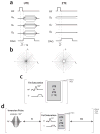

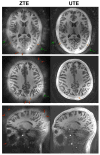
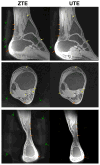
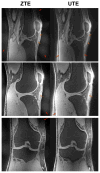


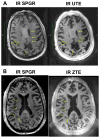

References
-
- Gold GE, Wren TAL, Nayak KS. In vivo short echo time imaging of Achilles tendon. Proceedings of the 9th Annual Meeting of ISMRM; Glasgow. 2001. p. 244.
-
- Robson MD, Benjamin M, Gishen P, Bydder GM. Magnetic resonance imaging of the Achilles tendon using ultrashort TE (UTE) pulse sequences. Clin Radiol. 2004;59:727–735. - PubMed
-
- Filho GH, Du J, Pak BC, Statum S, Znamorowski R, Haghighi P, Bydder G, Chung CB. Quantitative characterization of the achilles tendon in cadaveric specimens: T1 and R2* measurements using ultrashort-TE MRI at 3 T. AJR Am J Roentgenol. 2009;192:W117–24. - PubMed
-
- Grosse U, Syha R, Martirosian P, Wuerslin C, Horger M, Grözinger G, Schick F, Springer F. Ultrashort echo time MR imaging with off-resonance saturation for characterization of pathologically altered achilles tendons at 3 T. Magn Reson Med. 2013;70:184–92. - PubMed
-
- Juras V, Zbyn S, Pressl C, Valkovic L, Szomolanyi P, Frollo I, Trattnig S. Regional variations of T2* in healthy and pathologic achilles tendon in vivo at 7 tesla: preliminary results. Magn Reson Med. 2012;68:1607–13. - PubMed
MeSH terms
Substances
Grants and funding
LinkOut - more resources
Full Text Sources
Other Literature Sources
Medical

